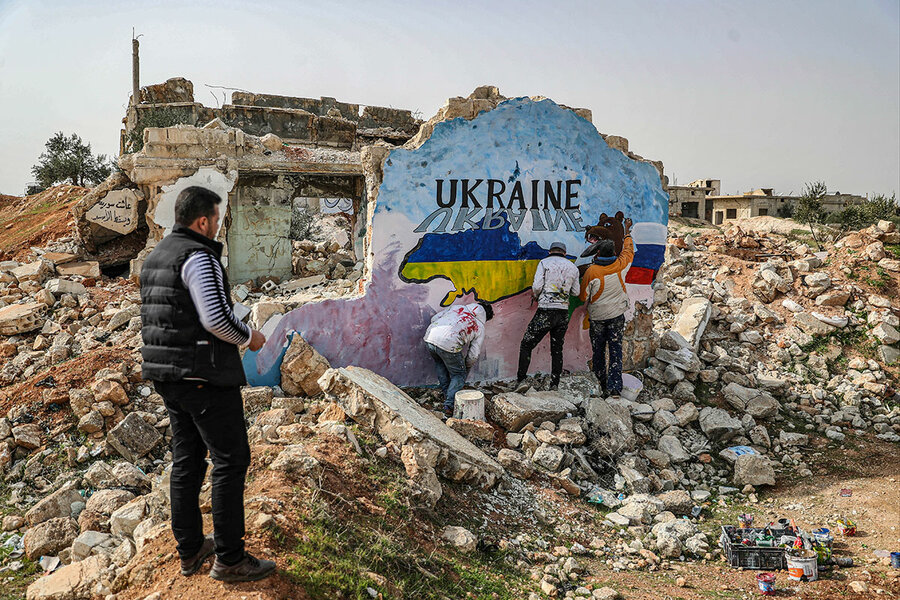Bombed hospitals, crushed cities. What Syrians recognize in Ukraine.
Loading...
| AMMAN, Jordan
On the 11th anniversary of Syria’s revolution, with no peace in sight, veterans and observers of the long conflict there say the parallels with Ukraine are hard to avoid. And as the Russian war in Ukraine deepens, they say that if Ukraine cannot repel the invasion, clues to that country’s future may be found in Syria’s present.
“I wouldn’t wish Russian aggression on any person or anyplace in the world, because it is bloody, brutal, it aims to break your will to live, and it never stops,” says Ismail Al Abdullah, a rescue worker with the White Helmets organization.
Why We Wrote This
Ukraine’s resilience in the face of Russia’s military onslaught has caught Syrians’ attention. They recall how relentless and brutal Russian tactics wore down their own resistance.
“I am watching the Russians trying to besiege Kyiv in the same manner they besieged Aleppo, and Homs,” he says. “It feels frustrating to see it happening all over again.”
In Syria today, the economy is in tatters, millions are still displaced, and the conflict grinds on. But the Kremlin could tolerate such a situation in Ukraine, and even claim it as a victory, suggests Natasha Hall, senior fellow at the Center for Strategic and International Studies.
“Russia has proven it is very comfortable with frozen conflicts,” she says. “They will accept a high amount of misery – as long as it is someone else’s misery.”
Ismail Al Abdullah, like other Syrians living in opposition-held northern Syria, knows the drill: Scan the sky. Don’t drive on an open road. Avoid crowds. And never, ever, trust a Russian cease-fire.
“I wouldn’t wish Russian aggression on any person or anyplace in the world, because it is bloody, brutal, it aims to break your will to live, and it never stops,” Mr. Al Abdullah, a rescue worker with the White Helmets organization, says over WhatsApp.
“I am watching the Russians trying to besiege Kyiv in the same manner they besieged Aleppo, and Homs, repeating the bombings and massacres I witnessed,” he says. “It feels frustrating to see it happening all over again.”
Why We Wrote This
Ukraine’s resilience in the face of Russia’s military onslaught has caught Syrians’ attention. They recall how relentless and brutal Russian tactics wore down their own resistance.
On the 11th anniversary of Syria’s revolution, with no peace in sight there, the parallels with Ukraine are hard to avoid.
As the Russian war in Ukraine deepens, and Moscow intensifies its bombardment and aerial campaign against Ukrainian cities, Syrians and outside observers say that if Ukraine cannot repel the Russian invasion, clues to that country’s future may be found in Syria’s present.
Urban shelling as strategy
One image from Ukraine this week was familiar to most Syrians: a bombed-out maternity hospital in Mariupol.
“Russia’s strategy is always to target hospitals, public facilities, rescue workers, anything that gives life or sustainability for civilians,” says Mr. Al Abdullah, who has been displaced three times by the war in Syria. “Their true aim is to kill and destroy the will of the people and make them flee their homes.”
Most devastating, perhaps, is the tactic known as “double-tap” bombing, when warplanes bomb a site, wait for a crowd to gather and rescue teams to arrive, and then circle back to strike a second time for maximum casualties.
Most of the 240 White Helmet volunteers who have been killed fell victim to that trick, Syrians say.
Analysts say it is part of a brutal and efficient strategy to force local people to surrender or leave their homes without the need for house-to-house fighting.
“In terms of approach, the indiscriminate shelling of urban areas is absolutely one that we have seen in Syria and in Chechnya; there is continuity here,” says Tracey German, a professor of conflict and security at King’s College London.
“Russians learned in their first intervention in Chechnya in the mid-1990s that sending troops into urban areas is a very difficult operation that requires a lot of troops and sends home a lot of coffins,” she points out.
Limits of Western involvement
Former Syrian fighters warn of another parallel between their battle and Ukraine’s – the West’s unwillingness to become fully involved, and to support a resistance struggle that could wane.
“The West gave us arms, training, and direction to fight [President Bashar] Al Assad, but without a no-fly-zone to protect us or our families, just as they are doing with the Ukrainians now,” says Abu Abdullah, a Syrian military deserter turned Free Syrian Army officer who fought Syrian government and Russian troops for four years.
Today Abu Abdullah – his name is a nom de guerre – lays tiles in a northern Jordanian village for $28 a day.
“The West’s support is fleeting, and democracies’ patience is thin. What will happen,” he wonders, “to these Ukrainians should the war drag on?”
Syrians warn of another tactic that Russian troops employed in their campaign against them – cease-fires that they used as opportunities to resupply.
“In Syria, Russians and the Al Assad regime used de-escalation periods and cease-fires to regroup and recoup before a major offensive. This is something to be on the lookout for in Ukraine,” says Natasha Hall, senior fellow at the Center for Strategic and International Studies (CSIS) in Washington.
In so-called de-escalation zones, opposition forces struck Russia-brokered deals with the regime to lay down their arms in return for security guarantees. But within months the regime would tear up these agreements and seize the de-escalation zone with Russian backing.
Um Suhaib and her family returned from Jordan to a de-escalation zone in southern Syria in 2018. “They said they were offering a peace, an amnesty,” says Um Suhaib, whose three nephews have been forcibly conscripted or disappeared since their 2018 return. “This regime and the Russians do not believe in cease-fires!”
Russia has also blocked many efforts by the United Nations and independent aid agencies to send humanitarian aid to besieged Syrian towns. Foreign aid workers complain privately that the Syrian government and Russia insist that aid goes through them so that they can skim most of it off for themselves.
Syria today, Ukraine tomorrow?
Seven years since Russia’s intervention in the Syrian civil war, peace has not returned.
A low-level conflict continues to simmer as militias roam the burned-out buildings that pockmark Syrian towns, and insurgents occasionally ambush a regime convoy.
Russia continues to carry out airstrikes on de-escalation zones and on the last rebel bastion in Idlib. Last week’s targets included chicken farms and a water station, according to the London-based Syrian Observatory for Human Rights (SOHR).
Syrian regime forces continue to arrest suspected dissidents and protesters in territories they control; the SOHR reports 45 people from the Damascus countryside were killed by torture in February alone.
The war and Western sanctions have led to the collapse of the Syrian currency, hyperinflation, constant gas and fuel shortages, and a struggle for many families to feed themselves.
Some 6.6 million Syrian refugees remain abroad with few prospects of return; 6.7 million internally displaced Syrians, living in Turkish-controlled areas, are largely reliant on outside aid.
The Kremlin could tolerate such a situation in Ukraine, and even claim it as a victory, suggests Ms. Hall, the CSIS analyst.
“Russia has proven it is very comfortable with frozen conflicts,” she says. “As long as they are not spending a gratuitous amount of treasure and blood, they will accept a high amount of misery – as long as it is someone else’s misery,” she adds.
Syria’s future
Syrians say their own fate, too, hangs in the balance in Ukraine.
Should Russia succeed in occupying large swaths of Ukrainian territory, Syrians fear an emboldened Vladimir Putin will back a final campaign to seize Idlib and clear the last remaining Syrian opposition stronghold of its 4 million residents.
“We in Northern Syria are watching events very closely. If Russia can capture Ukraine, we think the next step will be Idlib,” says Mr. Al Abdullah, the White Helmet volunteer. “It would be a green light. If the international community cannot protect Ukraine, consequently they won’t care about Idlib and the civilians here.”
But “things can be different,” Mr. Al Abdullah hopes. “Now Russia is a threat to international peace, the international community must respond. If they do not, another country and another people will face misery.”










